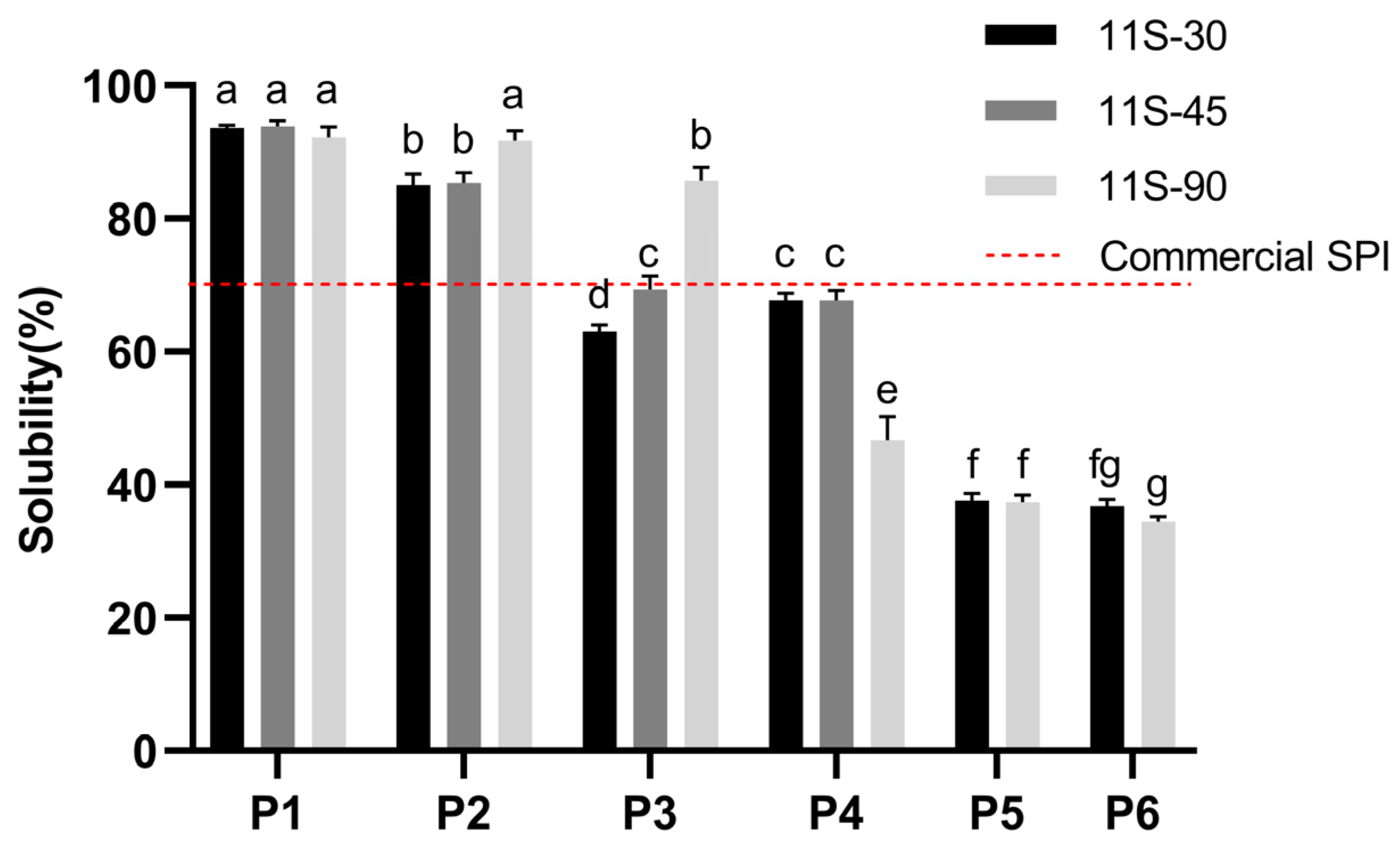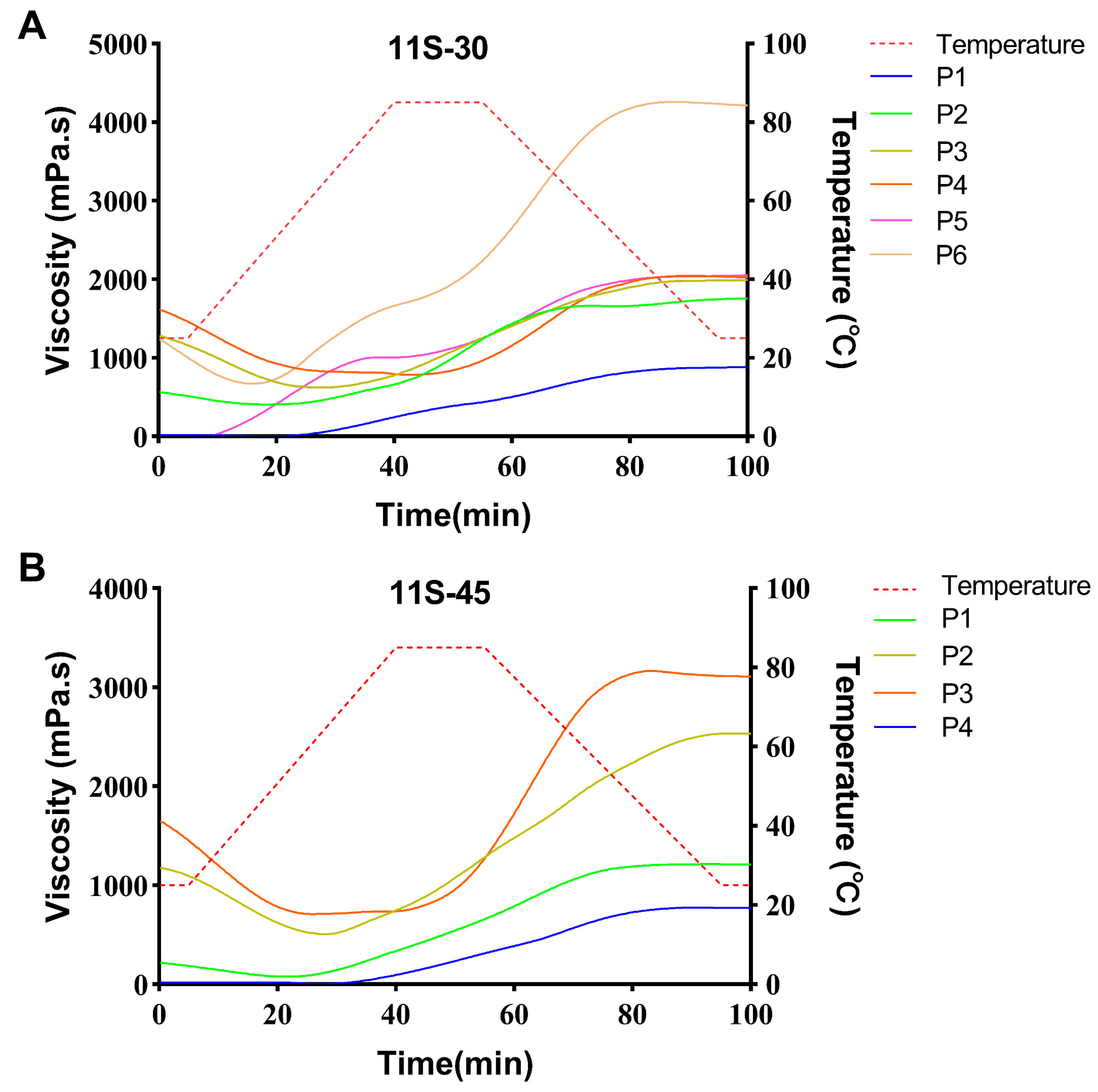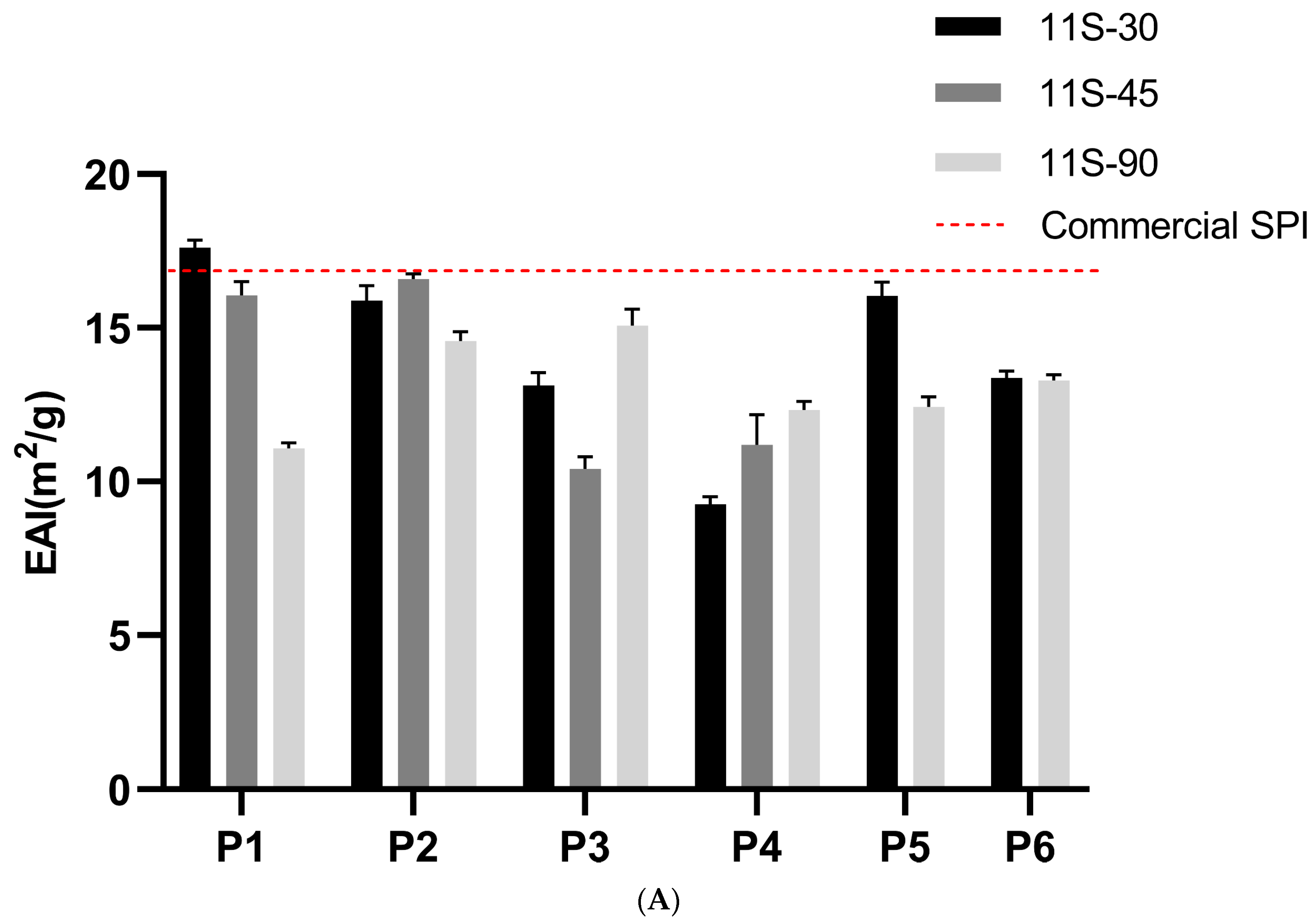Effect of Thermal Treatment on Gelling and Emulsifying Properties of Soy β-Conglycinin and Glycinin
Abstract
:1. Introduction
2. Materials and Methods
2.1. Materials and Chemicals
2.2. Preparation of Soy 7S Globulin and 11S Globulin
2.3. Preparation of Protein Samples
2.4. Protein Dispersibility Index (PDI)
2.5. Surface Hydrophobicity
2.6. Viscosity
2.7. Emulsifying Properties
2.8. Gel Strength
2.9. Statistical Analysis
3. Results
3.1. Solubility
3.2. Surface Hydrophobicity
3.3. Viscosity
3.4. Emulsifying Properties
3.5. Gel Strength
4. Conclusions
Author Contributions
Funding
Institutional Review Board Statement
Informed Consent Statement
Data Availability Statement
Conflicts of Interest
References
- Sijpestijn, G.F.; Wezel, A.; Chriki, S. Can agroecology help in meeting our 2050 protein requirements? Livest. Sci. 2022, 256, 104822. [Google Scholar] [CrossRef]
- Aiking, H. Future protein supply. Trends Food Sci. Technol. 2011, 22, 112–120. [Google Scholar] [CrossRef]
- Nieuwland, M.; Geerdink, P.; Brier, P.; Eijnden, P.v.D.; Henket, J.T.; Langelaan, M.L.; Stroeks, N.; van Deventer, H.C.; Martin, A.H. Reprint of “Food-grade electrospinning of proteins”. Innov. Food Sci. Emerg. Technol. 2014, 24, 138–144. [Google Scholar] [CrossRef]
- Sui, X.; Zhang, T.; Jiang, L. Soy protein: Molecular structure revisited and recent advances in processing technologies. Annu. Rev. Food Sci. Technol. 2021, 12, 119–147. [Google Scholar] [CrossRef] [PubMed]
- Prak, K.; Naka, M.; Tandang-Silvas, M.R.G.; Kriston-Vizi, J.; Maruyama, N.; Utsumi, S. Polypeptide modification: An improved proglycinin design to stabilise oil-in-water emulsions. Protein Eng. Des. Sel. 2015, 28, 281–291. [Google Scholar] [CrossRef] [PubMed]
- Qi, G.; Venkateshan, K.; Mo, X.; Zhang, L.; Sun, X.S. Physicochemical properties of soy protein: Effects of subunit composition. J. Agric. Food Chem. 2011, 59, 9958–9964. [Google Scholar] [CrossRef] [PubMed]
- Fukushima, D. Soy Proteins; Elsevier: Amsterdam, The Netherlands, 2011; pp. 210–232. [Google Scholar]
- Perrechil, F.A.; Ramos, V.A.; Cunha, R.L. Synergistic Functionality of Soybean 7S and 11S Fractions in Oil-in-Water Emulsions: Effect of Protein Heat Treatment. Int. J. Food Prop. 2015, 18, 2593–2602. [Google Scholar] [CrossRef]
- Damodaran, S.; Kinsella, J.E. Effect of conglycinin on the thermal aggregation of glycinin. J. Agric. Food Chem. 1982, 30, 812–817. [Google Scholar] [CrossRef]
- Liu, Q.; Geng, R.; Zhao, J.; Chen, Q.; Kong, B. Structural and gel textural properties of soy protein isolate when subjected to extreme acid pH-shifting and mild heating processes. J. Agric. Food Chem. 2015, 63, 4853–4861. [Google Scholar] [CrossRef]
- Mattil, K.F. Composition, nutritional, and functional properties, and quality criteria of soy protein concentrates and soy protein isolates. J. Am. Oil Chem. Soc. 1974, 51 Pt 1, 81A–84A. [Google Scholar] [CrossRef]
- Jiang, J.; Xiong, Y.L. Extreme pH treatments enhance the structure-reinforcement role of soy protein isolate and its emulsions in pork myofibrillar protein gels in the presence of microbial transglutaminase. Meat Sci. 2013, 93, 469–476. [Google Scholar] [CrossRef] [PubMed]
- Nagano, T.; Hirotsuka, M.; Mori, H.; Kohyama, K.; Nishinari, K. Dynamic viscoelastic study on the gelation of 7 S globulin from soybeans. J. Agric. Food Chem. 1992, 40, 941–944. [Google Scholar] [CrossRef]
- Iwe, M.O.; van Zuilichem, D.; Ngoddy, P.; Lammers, W. Amino acid and protein dispersibility index (PDI) of mixtures of extruded soy and sweet potato flours. LWT-Food Sci. Technol. 2001, 34, 71–75. [Google Scholar] [CrossRef]
- Chelh, I.; Gatellier, P.; Santé-Lhoutellier, V. A simplified procedure for myofibril hydrophobicity determination. Meat Sci. 2006, 74, 681–683. [Google Scholar] [CrossRef]
- Pearce, K.N.; Kinsella, J.E. Emulsifying properties of proteins: Evaluation of a turbidimetric technique. J. Agric. Food Chem. 1978, 26, 716–723. [Google Scholar] [CrossRef]
- Peng, X.; Guo, S. Texture characteristics of soymilk gels formed by lactic fermentation: A comparison of soymilk prepared by blanching soybeans under different temperatures. Food Hydrocoll. 2015, 43, 58–65. [Google Scholar] [CrossRef]
- Grossmann, L.; McClements, D.J. Current insights into protein solubility: A review of its importance for alternative proteins. Food Hydrocoll. 2023, 137, 108416. [Google Scholar] [CrossRef]
- McClements, D.J.; Grossmann, L. The science of plant-based foods: Constructing next-generation meat, fish, milk, and egg analogs. Compr. Rev. Food Sci. Food Saf. 2021, 20, 4049–4100. [Google Scholar] [CrossRef] [PubMed]
- Niu, H.; Xia, X.; Wang, C.; Kong, B.; Liu, Q. Thermal stability and gel quality of myofibrillar protein as affected by soy protein isolates subjected to an acidic pH and mild heating. Food Chem. 2018, 242, 188–195. [Google Scholar] [CrossRef]
- Renkema, J.M.; Lakemond, C.M.; de Jongh, H.H.; Gruppen, H.; van Vliet, T. The effect of pH on heat denaturation and gel forming properties of soy proteins. J. Biotechnol. 2000, 79, 223–230. [Google Scholar] [CrossRef]
- Mir, N.A.; Riar, C.S.; Singh, S. Improvement in the functional properties of quinoa (Chenopodium quinoa) protein isolates after the application of controlled heat-treatment: Effect on structural properties. Food Struct. 2021, 28, 100189. [Google Scholar] [CrossRef]
- Liu, Z.; Chang, S.K.C.; Li, L.-T.; Tatsumi, E. Effect of selective thermal denaturation of soybean proteins on soymilk viscosity and tofu’s physical properties. Food Res. Int. 2004, 37, 815–822. [Google Scholar] [CrossRef]
- Guo, J.; Yang, X.-Q.; He, X.-T.; Wu, N.-N.; Wang, J.-M.; Gu, W.; Zhang, Y.-Y. Limited Aggregation Behavior of β-Conglycinin and Its Terminating Effect on Glycinin Aggregation during Heating at pH 7.0. J. Agric. Food Chem. 2012, 60, 3782–3791. [Google Scholar] [CrossRef] [PubMed]
- Ju, Q.; Yuan, Y.; Wu, C.; Hu, Y.; Zhou, S.; Luan, G. Heat-induced aggregation of subunits/polypeptides of soybean protein: Structural and physicochemical properties. Food Chem. 2023, 405, 134774. [Google Scholar] [CrossRef] [PubMed]
- Guo, F.; Xiong, Y.L.; Qin, F.; Jian, H.; Huang, X.; Chen, J. Surface properties of heat-induced soluble soy protein aggregates of different molecular masses. J. Food Sci. 2015, 80, C279–C287. [Google Scholar] [CrossRef] [PubMed]
- Chan, J.T.; Omana, D.A.; Betti, M. Application of high pressure processing to improve the functional properties of pale, soft, and exudative (PSE)-like turkey meat. Innov. Food Sci. Emerg. Technol. 2011, 12, 216–225. [Google Scholar] [CrossRef]
- Xu, J.T.; Liu, H.; Ren, J.H.; Guo, S.T. Assessment and distinction of commercial soy protein isolate product functionalities using viscosity characteristic curves. Chin. Chem. Lett. 2012, 23, 1051–1054. [Google Scholar] [CrossRef]
- Wang, J.; Navicha, W.B.; Na, X.; Ma, W.; Xu, X.; Wu, C.; Du, M. Preheat-induced soy protein particles with tunable heat stability. Food Chem. 2021, 336, 127624. [Google Scholar] [CrossRef]
- Kimura, A.; Tandang-Silvas, M.R.G.; Fukuda, T.; Cabanos, C.; Takegawa, Y.; Amano, M.; Nishimura, S.-I.; Matsumura, Y.; Utsumi, S.; Maruyama, N. Carbohydrate moieties contribute significantly to the physicochemical properties of French bean 7S globulin phaseolin. J. Agric. Food Chem. 2010, 58, 2923–2930. [Google Scholar] [CrossRef]
- Rivas, H.J.; Sherman, P. Soy and meat proteins as emulsion stabilizers. 4. The stability and interfacial rheology of O/W emulsions stabilised by soy and meat protein fractions. Colloids Surf. 1984, 11, 155–171. [Google Scholar] [CrossRef]
- Nishinari, K.; Fang, Y.; Guo, S.; Phillips, G. Soy proteins: A review on composition, aggregation and emulsification. Food Hydrocoll. 2014, 39, 301–318. [Google Scholar] [CrossRef]
- Tang, C. Emulsifying properties of soy proteins: A critical review with emphasis on the role of conformational flexibility. Crit. Rev. Food Sci. Nutr. 2017, 57, 2636–2679. [Google Scholar] [CrossRef] [PubMed]
- Wu, C.; Hua, Y.; Chen, Y.; Kong, X.; Zhang, C. Effect of temperature, ionic strength and 11S ratio on the rheological properties of heat-induced soy protein gels in relation to network proteins content and aggregates size. Food Hydrocoll. 2017, 66, 389–395. [Google Scholar] [CrossRef]







Disclaimer/Publisher’s Note: The statements, opinions and data contained in all publications are solely those of the individual author(s) and contributor(s) and not of MDPI and/or the editor(s). MDPI and/or the editor(s) disclaim responsibility for any injury to people or property resulting from any ideas, methods, instructions or products referred to in the content. |
© 2024 by the authors. Licensee MDPI, Basel, Switzerland. This article is an open access article distributed under the terms and conditions of the Creative Commons Attribution (CC BY) license (https://creativecommons.org/licenses/by/4.0/).
Share and Cite
Zhang, W.; Jin, M.; Wang, H.; Cheng, S.; Cao, J.; Kang, D.; Zhang, J.; Zhou, W.; Zhang, L.; Zhu, R.; et al. Effect of Thermal Treatment on Gelling and Emulsifying Properties of Soy β-Conglycinin and Glycinin. Foods 2024, 13, 1804. https://doi.org/10.3390/foods13121804
Zhang W, Jin M, Wang H, Cheng S, Cao J, Kang D, Zhang J, Zhou W, Zhang L, Zhu R, et al. Effect of Thermal Treatment on Gelling and Emulsifying Properties of Soy β-Conglycinin and Glycinin. Foods. 2024; 13(12):1804. https://doi.org/10.3390/foods13121804
Chicago/Turabian StyleZhang, Wei, Mengru Jin, Hong Wang, Siqi Cheng, Jialu Cao, Dingrong Kang, Jingnan Zhang, Wei Zhou, Longteng Zhang, Rugang Zhu, and et al. 2024. "Effect of Thermal Treatment on Gelling and Emulsifying Properties of Soy β-Conglycinin and Glycinin" Foods 13, no. 12: 1804. https://doi.org/10.3390/foods13121804




